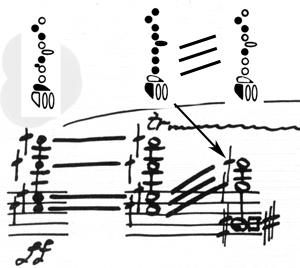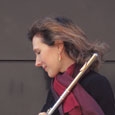.jpg) Shun-San (Spring Glory) is a powerful, challenging work by Kazuo Fukushima in which time is dictated by breath, and space is woven by sounds and silence. Like his more popular work Mei, Shun-San is a confluence of several artistic sources: the blossoming avant-garde of the 1960s, Japanese Noh theater, and other elements of traditional Japanese music. It may be performed on an open or closed-hole flute with B or C foot.
Shun-San (Spring Glory) is a powerful, challenging work by Kazuo Fukushima in which time is dictated by breath, and space is woven by sounds and silence. Like his more popular work Mei, Shun-San is a confluence of several artistic sources: the blossoming avant-garde of the 1960s, Japanese Noh theater, and other elements of traditional Japanese music. It may be performed on an open or closed-hole flute with B or C foot.
Fukushima was born in Tokyo, Japan in 1930. Largely self-taught in composition, he started making international waves with his compositional style in 1958, when his flute and piano piece, Ekagra, won a contemporary music competition. He composed three pieces for unaccompanied flute: Requiem in 1956, Mei in 1962, and Shun-San in 1969, which is his final work for unaccompanied flute to date. He was kind enough to offer me the following information: “All of my works that preceded Shun-San have the common characteristic of requiem. In 1945 the war ended, I was 15 years old. Before the war my family had seven members, after the war, four. Several times I myself barely escaped death. Death was our neighbor and many young people lost their lives. It was natural for me when I composed that my pieces became a requiem. Mei is a requiem to a certain person (Dr. Wolfgang Steineke), the other works, if I must say, are for the young people [who] lost their lives in the world war. Shun-San was written for two new-born lives, my daughter Sayaka and my son Yoshiharu.(…) Life and death are two sides of one medallion.”1 Thus, Shun-San, Spring Glory, was written to celebrate the young lives of his children – a hymn to life after decades of mourning.
As in Mei, we hear gestures that suggest the essence of Noh theater and its traditional flute, the noh-kan. Whether Fukushima intended or not, I also hear echos of the ryuteki (the classical bamboo flute used in gagaku, the court music of Japan) and shakuhachi (a popular, Japanese end-blown bamboo flute). Perhaps Fukushima knew that a meeting between East and West would be more harmonious if the weight of their history was left behind. Therefore, in Shun-San the gestures of traditional Japanese music have been stripped of their semantic role and technical framework. This means we do not need to be experts in traditional Japanese musical genres to perform this work. However, to absorb and evoke Fukushima’s musical language we should familiarize ourselves with the sounds that inspired him.*
The score, a facsimile of the composer’s manuscript, suggests exquisite calligraphy. The spacial notation allows for true flexibility, because it is not marked by measures as in Luciano Berio’s Sequenza (1958) or Toru Takemitsu’s Voice (1971). Length is indicated by line, silence by space. It is that simple.
The fingering system, embouchure/air pressure indications (those strange circles and squares), and multiphonics are taken from Bruno Bartolozzi’s New Sounds for Woodwinds. The multiphonics in this work are problematic. Bartolozzi most likely based his multiphonics on guesswork and the erroneous assumption that if a finger generates a certain number of pitches, multiphonics can be made from all of those pitches. I have proposed some alternatives.
Fukushima stated in his correspondence with me that the player is free to find fingerings that work for him/her.2 To continue the spirit of search and discovery that characterized the mid-20th century avant-garde, I consider it appropriate to seek alternate fingerings even for notes marked “N” (meaning normal fingering) if they enhance the coloristic context. (It is not only Early Music buffs who are faced with questions of Historical Performance Practice!)
There are also traditional considerations for varying either fingerings or the amount of air in the sound. According to D. P. Berger’s article, “The Nohkan: Its Construction and Music,” “because of [the noh-kan’s] large mouth hole, 20 mm in length and 15 mm in width, a great deal of air is necessary to produce a tone. The noise of the excess air is also considered part of the flute’s tone. This idea of the importance of noise in relation to purely musical sound is a feature that is very important in traditional Japanese music.”3
He further states that in the varying nohkan, shakuhachi, and ryuteki traditions, the tongue is not used for articulation. Accents and repeated notes are executed with a combination of the breath and fingers. Shun-San embraces elements of Western classical flute playing, so do not forgo use of the tongue, but use it sparingly.
Intonation often falls by the wayside in unaccompanied flute pieces. I do not propose that one play this work with equal temperment or any particular tuning system. Nevertheless, we must take care because Shun-San derives much of its tension from linear (and sometimes vertical) play of very small intervals. Quarter-tones need not be an exact 50 cent deviation. They may be less, as long as they differentiate enough so that the ear can distinguish them.
Another thing to consider: the Japanese noh-kan and ryuteki flutes over-blow a less-than-perfect octave. Fukushima often uses sevenths melodically; perhaps they could be construed as “octaves”? Indeed, instability of pitch is one hallmark of these traditional flutes. When you transfer this instability to your modern flute, make your decisions consciously. Effective use of intonation adds character and helps the listener to understand, even subliminally, an interval’s context and its connections.
The Score
Play notes under a slur in one breath; otherwise breathing and phrasing are free.
.jpg)
Line 1: Take a moment before beginning to leave the industrial age behind. It is just you and the bamboo. Your pacing will now reflect the essence of spirit rather than the ticking of a metronome. (Spirit in the literal sense, spiritus being the Latin word for breath.) D. P. Berger describes how a noh-kan player prepares:
The player is seated on the floor with his legs drawn under his body – a formal Japanese position. Before the flute is brought to the lips it is held vertically on the right leg with the right hand. At the precise moment in the music it is slowly, and with great dignity, brought to the lips in a ready position. … [I]n the Noh the visual aspect of even something as seemingly unimportant as bringing the flute to the lips is, to the contrary, extremely important.4
As an example of the coloristic freedom you have, think about the different ways to produce the crescendo of the first G#. You could actually play louder by blowing more, or you could make a color change from light to dark by changing the position of the tongue from eeh to aah. “Changing the harmonic components of the sound” is a fancy way of describing this. You could add vibrato and vary its speed and amplitude as you crescendo. Any one element or combination of these elements can work.
Line 2: In the middle of the line, the C followed by three notes without a staff indicates a repetition, which I prefer to do with a breath accent. This entire middle phrase should ideally be played in one breath. If you find that difficult, play the B natural forte with a dense, dark sound without using a lot of air. Save it, increase the vibrato towards the end. Because the tempo is free, you could consider playing the first four notes rather quickly.
Line 4: The fff on the seventh note, C, needs to be done “virtually” because the given fingering produces a diffuse sound. Create intensity with vibrato or excess air. Do not linger, move toward the multiphonic, keeping the same fingering. Do not worry about the outer notes of the multiphonic, if you only hit C and D 1/4# together, that is fine. Do not linger on that either; keep moving to isolate the D 1/4#, again, keeping the same fingering, crescendo, then let it rip for the high B. The timbral trill on F (the 11th note) is more effective with the C key of the footjoint held down. (A timbral trill is a trill of color change on a given pitch, as opposed to a trill between two pitches.) The next note, the G# timbral trill, has a mistake in the fingering, the number 3 (meaning the G# key) is missing. You can add the foot joint keys for this trill as well. The last two trills I also do differently:
.jpg)
Line 5: The first tremolo is a good place for a breathy accent at the beginning.
.jpg)
For the next gesture, trill with the first trill key, then over-blow to produce each high E. For the first three multiphonic tremolos, I use slightly different fingerings. (see below)
These tremolos do not need to be fast. Keep them slow enough so the lips can produce pandemonium. In the grace note gesture of the fifth tremolo, play the D# as an overblown G# to facilitate fingering to high B. The last tremolo can be done with an
.jpg)
accelerando, which will intensify the crescendo. I personally leave out the high A and go for trill speed and dynamic. The fingering of the last note of the line (C 1/4#) is a mistake. Use low F without the thumb (you may even half-hole the F key if you have an open-holed flute).
Line 6: If you have a closed hole flute, play the “port.” (meaning portato, glissando) by slowly adding the first trill key. The next portato, on the C marked mp, should not be fingered. Use a combination of head, jaw, and turning the flute in and out. The multiphonic on Aflat/G does not produce a real forte, but it can be made to sound noisy. The next note, G, may be fingered normally, or you may keep the previous fingering from the multiphonic for a more colored effect.
Line 7: I use a different fingering for the ff multiphonic and tremolo.

Again, it doesn’t need to be fast. You could think of it as an aftershock of the preceding page: hold the intensity as if you are filling the room with hot air, then deflate abruptly to a ppp G#.
Line 8: Play repeated D#s with breath accents, then add the tongue for the written accent. This fff dissipates in a lovely arc of timbral trills, like the shimmering fallout of an exploded firework. If absolutely necessary, breathe before the E trill at the beginning of the slur line; otherwise this is a great place to exercise circular breathing. The high F trill fingering is missing the 7 (D# key). The repeated C-C# figure at the end of the line is a typical bamboo flute gesture, and we should do our best to make it sound as if we are tapping an open hole rather than operating a lever.
.jpg)
Too bad we can’t grow temporary tentacles to reach the actual C and C# holes on the footjoint! Instead, place the pinky so that there is as little movement as possible when going from the C to C# lever. Don’t start with the tongue, you may give a slight emphasis to the first grace note with the air, but play the following grace notes rather weakly, leaning on the C#.
Line 9: Turn in slightly for the D 1/4# so that it sounds distinct from the D#. This modest four-note melody continues the bamboo flavor of the previous line. For the next mf D, turn the flute very far out.
Flutists often encounter difficulty with small-interval multiphonics because they are hung up on trying to produce a focus immediately. That is difficult to do when you are blowing in two directions at once. The irony of these small-interval multiphonics is, at first, you have to unfocus to get the sense of focus. Open up the embouchure hole and let both notes in. Initially there will be a lot of air, but with practice you can refine them. They will sound focused and rich because of the very low difference tone caused by a close interval. When you get the hang of playing these small intervals, it may help to focus on producing this difference tone rather than the individual notes themselves. That may seem strange but sometimes it works.
Be conscious of the play of small intervals that precede the D-C multiphonic in Line 9. The color you use for these linear fragments can help prepare the listener for the multiphonics. Your coloristic preparation will allow the listener to stay tuned, as a storyteller can suspend disbelief in order to weave a good story. In this passage if you play with a sound that is too metallic or direct, the sudden multiphonic color may create a confusing aural juxtaposition. I believe there is enough contrast already composed into the piece, and if you keep banging your listeners over the head, they will at some point tune out. The next pair of multiphonics are written with the lower note in parentheses. Bring in the shadow of the lower note to add some roughness to the sound then, as indicated, fade out the lower note. The note becomes thinner but more tough and intense, as if it’s having something squeezed out of it. My strategy for the last multiphonic G#/G 1/4# is to let the G# an octave higher sound. This intensifies the beating effect in the longest and funkiest of the small intervals so far.
Line 11: The first multiphonic can present problems if played as written. If you blow enough to produce all the notes, you will likely run out of air after a few seconds. My idea is to shape it thus:
.jpg)
with a breath accent, shriek out the top note in true noh-kan style, let it fall away, bring back the dynamic a bit, then isolate the E 1/4# (which may sound closer to an F). The portato may be done by turning the flute in, or partially depressing and opening the ring of the A-key (left hand middle finger). The “pattering effect” is a thumb trill while fingering low C, then low C#. It is not a trill between C and C#. The last B 1/4b is fingered with the D# key, not the C key.
Line 12: The circles over high G and A indicate whistle tones. The fragile, ephemeral nature of Spring is made audible in this last line. The last two notes should be distinctly different in dynamic. Use vibrato on the long held notes according to your taste. Bear in mind that a very quiet low C will likely have something in the sound. Even the blood pulsing through your lips will make tiny variations in pitch, just as a line of calligraphy that seems straight from a distance will reveal small deviations and miniscule blotches when viewed closely. These flaws are its beauty, without them there would be no artistry. It is attention to these fine details that will bring your performance to life.
*For a detailed background of Fukushima’s esthetics, read Mihoko Watanabe’s excellent article “The Essence of Mei” published in The Flutist Quarterly, Spring 2008.
Footnotes:
1 E-mail correspondence February 21, 2010. Daisuke Kinoshida translated my questions into Japanese, then translated Fukushima’s answers into German. My translation is from the German.
2 ibid.
3 Berger, Donald Paul. “The Nohkan: Its Construction and Music”, Ethnomusicology, Vol. 9, No. 3 (September 1965). pp. 221-239.
4 ibid.
Bibliography
Bartolozzi, Bruno. New Sounds for Woodwinds, New York: Oxford University Press, 1967, 1982.
Berger, Donald Paul. “The Nohkan: Its Construction and Music”, Ethnomusicology, Vol. 9, No. 3 (September 1965). pp. 221-239.
Dick, Robert. Tone Development Through Extended Techniques, St. Louis: Multiple Breath, 1986.
Watanabe, Mihoko. “The Essence of Mei”, The Flutist Quarterly, Spring 2008. pp. 16-24.






